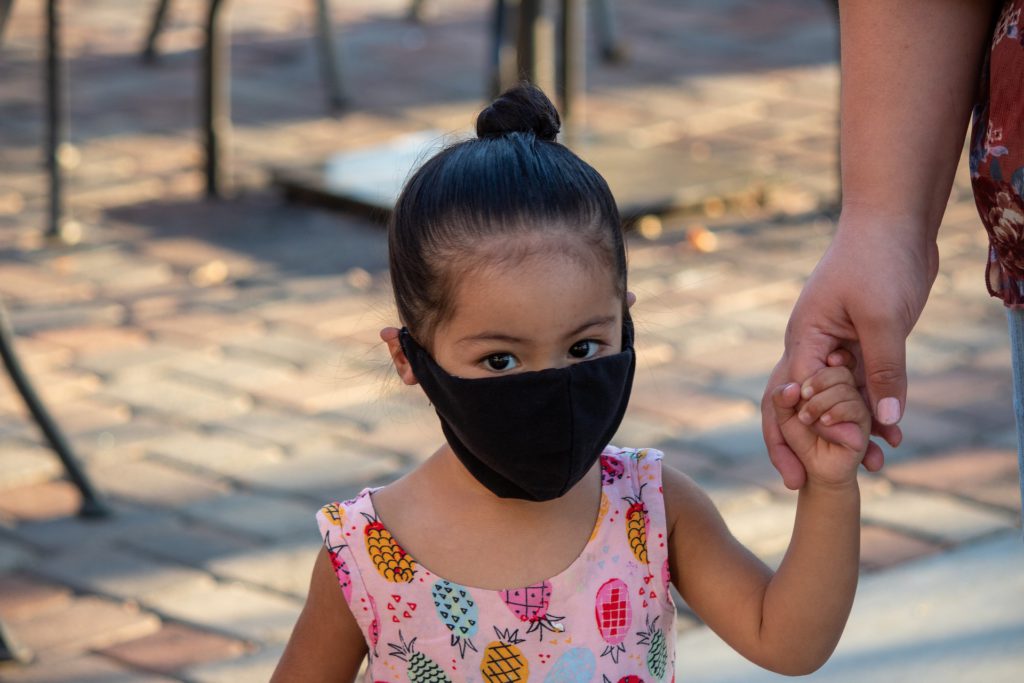On the 10th of October 2021, people around the world marked World Homeless Day in many varied ways. The purpose of World Homeless Day is to draw attention to people who experience homelessness needs locally and provide opportunities for the community to get involved in responding to homelessness. We are pleased to raise the visibility of this issue in our state.
Families with young children experiencing homelessness are nearly invisible. Child Care Services Association recently released a report on early childhood homelessness finding that 30-40% of those who are homeless are families with young children. But, because families often stay with friends or extended family, stay in motels and hotels, sleep in cars and stay in shelters rather than sleep on the streets, childhood homelessness is often hidden from public view.[1]
We can and should address the root causes of homelessness in addition to providing services, including early intervention support for young children in these families. Good jobs. Access to affordable housing. Access to medical care, including mental health services. These are but some of the challenges that land a family into experiencing homelessness.
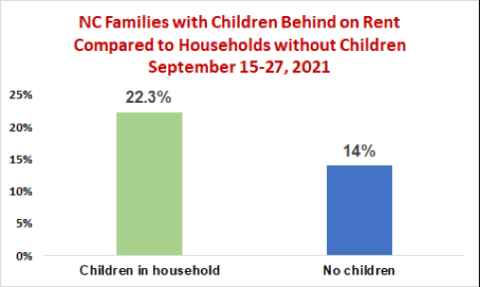
The most recent U.S. Census Household Pulse Survey (conducted between September 15-27, 2021) reveals the current pipeline for future potential homelessness.
Across the country, 21% of families with children compared to 10.3% of households without children are behind on rent.[2]
For North Carolina, 22.3% of families with children compared to 14% of households without children are behind on rent.[3]
Throughout the country, of households behind on rent, 9.1% are White and 22.7% are Black.[4]
For North Carolina, 7.5% of households behind on rent are White while 33.9% are Black.[5]
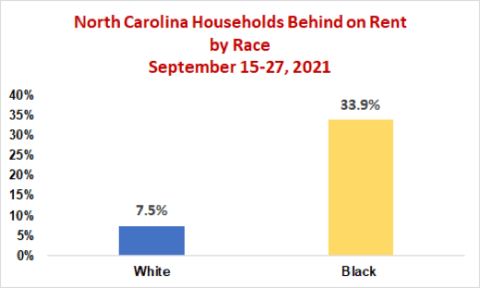
When the Census Bureau asked renters about whether they felt they could make next month’s rent payment, 35.4% of families with children were very concerned or somewhat concerned that they might not be able to pay next month’s rent.[6]
For North Carolina, 32.4% of families with children expressed concern about the ability to pay next month’s rent – 16.8% of White households compared to 35.4% of Black households.[7]
Throughout the country, of households behind on rent payments, 40.3% of families with children are worried that they might be evicted in the next two months.[8] Eviction is allowable since the Supreme Court rejected the CDC’s temporary moratorium on evictions in August.
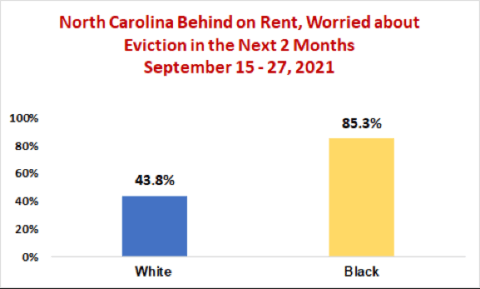
For North Carolina, of households behind on rent payments, 59.3% of families with children are worried about being evicted in the next two months. This includes 7,312 households who include an adult in the reserve or national guard.[9]
For North Carolina, of households behind on rent payments, 43.8% of White households are worried about eviction while 85.3% of Black households worry about eviction.[10]
There are many reasons why a family may experience homelessness. The behind-on-rent pipeline that ends in eviction is certainly one of them. The Center on Budget and Policy Priorities released an analysis last week that showed waiting lists for housing assistance throughout the country. These are low-income families who qualify for housing subsidies but do not receive them due to insufficient funding. Only one out of every four households that is eligible for rental assistance receives it.[11] Families who ultimately receive housing vouchers on average spend two and one-half years on waiting lists,[12] and many families on waiting lists never receive a voucher because the lists are so long and the voucher program is under-funded. And, this is data that was publicly known prior to the pandemic, which exacerbated the gap between those who can pay rent and those who struggle to pay it.
Emergency rental relief has been slow to respond to the rising demand. But, that’s temporary help. The underlying problem is that 16 million low-income households paid more than 30 percent of their income for rent or lived in overcrowded conditions before the public health pandemic.[13] If we are going to address homelessness, we need to start by addressing root causes – families paying more than 30% of their income for rent. The Build Back Better plan pending in Congress includes $75 billion for new Housing Choice Vouchers that are targeted to extremely low-income households, including $24 billion for those experiencing or at risk of homelessness.[14]
Community solutions are also possible. For example, Willard Street Apartments in Durham, N.C., offers 82 low-rent apartments for low and moderate income households using a mix of resources, including low income housing tax credits.[15] This project was possible through community leadership and collaboration. Orange County and Wake County are having community conversations as well.
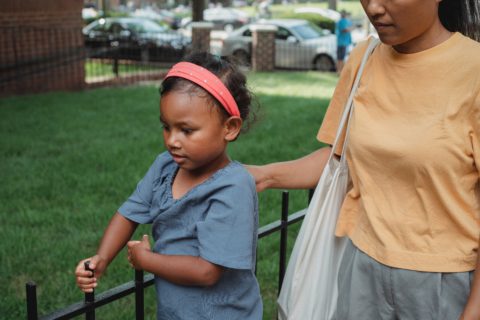
Homeless families with children need not be invisible. We see the pipeline. Temporary resources are beginning to flow, but those are more like band-aids. More permanent resources are needed. For families with children under age 6, we need to focus on both the importance of nurturing the early childhood years with safe and secure housing and also early learning opportunities to develop the brain, which lays the foundation for lifelong learning.
While we wait to see whether there will be progress in passing the Build Back Better Act pending in Congress, it’s time for communities to come together to collaborate on affordable housing initiatives for families with young children, and to look for every opportunity possible to provide supportive services, including early intervention services, for families with children under age 6 experiencing homelessness. The future trajectory of children depends on it.
[1] Child Care Services Association, An Invisible Crisis: Early Childhood Homeless – A Primer, 2021.
[2] U.S. Census Bureau, Household Pulse Survey, September 15 – 27, 2021. Table 1b, Last Month’s Payment Status for Renter-Occupied Housing Units, by Select Characteristics.
[3] Ibid.
[4] Ibid.
[5] Ibid.
[6] U.S. Census Bureau, Household Pulse Survey, September 15 – 27, 2021. Table 2b. Confidence in Ability to Make Next Month’s Payment for Renter-Occupied Housing Units, by Select Characteristics.
[7] Ibid.
[8] U.S. Census Bureau, Household Pulse Survey, September 15 – 27, 2021. Table 3b. Likelihood of Having to Leave this House in Next Two Months Due to Eviction, by Select Characteristics.
[9] Ibid.
[10] Ibid.
[11] Center on Budget and Policy Priorities, Long Waitlists for Housing Vouchers Show Pressing Unmet Need for Assistance, October 6, 2021.
[12] Ibid.
[13] Ibid.
[14] H.R. 5376, the Build Back Better Act, as reported to the House Rules Committee, September 27, 2021.
[15] North Carolina Housing Coalition, Willard Street Apartments are a Model for Affordable Housing, October 6, 2021.
